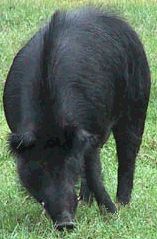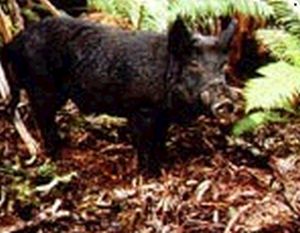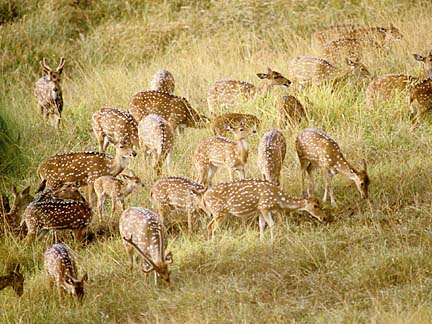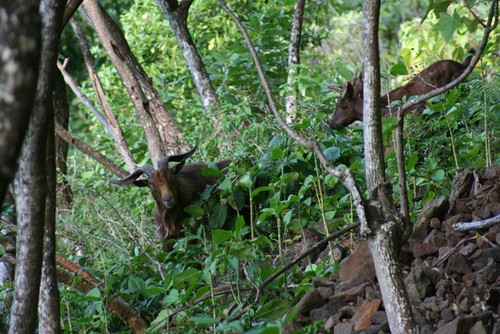| State of Hawaii Hunting Info What you need to know about hunting in the Aloha State. |
| Hunting License Game Mammals Game Birds State-wide Rules and Regulations Check rules for specific islands and their hunting areas Kaua'i O'ahu Moloka'i Lana'i Maui Big Island |
| There are 7 species of game mammals available in Hawaii's public hunting areas: 1) Feral Pig (sus scrofa) 2) Axis Deer (axis axis) 3) Columbian Black-tailed Deer (odocoileus hemionus columbianus) 4) Feral Goat (capra hircus hircus) 5) Mouflon Sheep (ovis musimon) 6) Feral Sheep (ovis aries) 7) Mouflon-feral Hybrid Sheep (ovis musimon x ovis aries) * other game mammals may be designated by the division **The hunting of Brush-tailed rock-wallaby, pronghorn, and feral cattle is prohibited |
| Feral Pig DESCRIPTION: The Early Polynesian voyagers brought pigs with them to the islands and their decendants still roam the island of Hawaii today. High on the slopes of Mauna Kea and Mauna Loa and on Kauai, one still finds a smaller pig, averaging 125 pounds, which is usually black and heavily haired; this is believed to be the Polynesian type. Later introductions were made of domestic breeds from all over the world as well as the European wild boar. Consequently, on the islands of Kauai, Oahu, Molokai, Maui, and parts of Hawaii, there is a mixture of size and colors, ranging from black through red to white. These pigs often weight over 200 pounds, and ocasionally range up to 400 pounds and up. RANGE: All Major islands except Lanai where they were exterminated many years ago. Today they live primarily in the wet forest, but if undisturbed, do well in the lower dry forest and scrub as well as pasture lands. |
 |
 |
| Polynesian boar, like this one from a Big Island fern forest, average somewhat smaller than the domestic breeds of pigs which excaped from farms or released. |
| BREEDING: Sows reach the age of puberty at 3 to 5 months and bear litters of 2 to 8 piglets although litters of up to 14 are not unherd of. The gestation period is 110 to 116 days. FOOD PREFERENCES: Pigs, being omnivorouse, will eat allmost any animal or plant matter, living or dead but thrive primarily on roots, tender plant stalks, fruits, and where abundant, earthworms. HUNTING AND EATING QUALITIES: The majority of pig hunting is done with the use of dogs; indeed, this is about the only way to bag a pig in the dense rainforest where the greatest populations occur. This is a thrilling sport with many hunters using only a long knife to dispatch the pig while the dogs hange on to it's snout, ears, and skin. Tackling a 200 pound boar with tusks up to 3 or 4 inches long is not for the clumsy or hesitant hunter. The next best manner is still hunting early or late in the day (pigs usually bed down in the middle of the day), if the bush isn't too thick, in areas with fresh rooting. Tree stand and ground blinds also work well. Pigs taken in dryer habitat are invariably good eating but pigs from the fern forests often aquire the flavor of the vegetation. |
| Most pigs in Hawaii are hybreds of Polynesian pig with European wild boar and/or domestic breeds. |
| 1 |
| 2 |
| Axis Deer DESCRIPTION: Males antlered part of the year, females never. Bucks stand about 3 1/2 feet at the shoulder, averaging 160 pounds live weight, but with weights up to 229 pounds recorded. Females average 90 pounds. Both sexes are spotted for life; the nikel-sized white spots arranged in rows from the neck backwards, the throat, belley, and inside of legs are a cream-white, and a black dorsal stripe runs down the spine. Old bucks often turn a grizzled charcoal-gray about the face, neck and forequarters- usually a sure sign of a trophy! RANGE: The major huntable populations are on the islands of Molokai and Lanai but large populations also occur on areas of Maui with most of the deer living in the dry forest between Kihei and Kaupo. Axis deer |
 |
| prefer an open, parkland forest, suck is found in the kiawe (mesquite) zone. They have also become established in the dense rain forest. The native range is in the parkland forests of India and Ceylon. BREEDING: Axis deer in Hawaii, like their brethren in India, breed at varying times throughout the year. Consequently one can always finds bucks in various stages of antler development. Only one fawn is produced each year, with a fawning peak in December, January and February. The mild climate permits excellent fawn survival. |
FOOD PREFERENCES: In lower dry areas, kiawe, klu, lantana, and guinea grass are favored; Hilo grass, drymaria, ulei, and pukiawe are prime foods in the higher, wet areas. |
 |
HUNTING AND EATING QUALITIES: Hunted on public hunting areas in March and April, the unique antler formation of this deer (always 3 |
| points) make it a treasured trophy. Axis deer have a flavor of their own, tasting nothing like mainland deer; it is considered one of the best wild meats. |
| Axis deer on maui are found primarily on private lands and are viewed as pests because of their garden-raiding habits. |
| Black-tailed Deer (No good picture exists. Check the picture pages on the Boar Hunter's Lair Website) DESCRIPTION: A distinct race of the Rocky Mountain mule deer, the black-tailed deer is somewhat smaller than the true "mulies". Antlers are dropped each year about January; shortly thereafter regrowth begins and new antleres are fully developed by August. Mature bucks range between 130 and 190 pounds averaging 160 pounds, with records up to 207 pounds. Does weight much less, averaging 125 pounds when mature. Only fawns have spotted coats. Adults are grey-brown durring the fall and winter months, molting to a reddish-brown coat durring the spring and summer. The forehead and outer tail are black. RANGE: Native to the northwest coast of the united states, Kauai's black-tailed deer were obtained from the state of Oregon. They were first released in 1961 in the Pu'u Ka Pele Game Management area on western Kauai. Taday, they can be found in low-to-fair numbers from the the top of Kalalau Valley to Polihale to the Waimea Canyon and perhaps even in the land lying to the east of the Waimea Canyon. But the best deer hunting occurs in the brushy broken ridgeland lying west of the Waimea Canyon. Black-tailed deer prefer dense cover intermingled with open meadows and ridge shoulders. BREEDING: Kauai black-tailed deer have a breeding cycle similar to their mainland kin. Breeding takes place between October and December. The gestation period is about 7 months and fawns are born btween April and June. Twins are not uncommen for older does, though younger does usually bear a single fawn. A less definate fawning peak occurs in Hawaii than in mainland herds. FOOD PREFERENCES: Browse and fruits are prefered over grasses. Guava fruit, passion fruit flower and vines, uki uki, mushrooms, koa shoots, and horseweed are prime food used by deer throughout their range. HUNTING AND EATING QUALITIES: Usually hunted in October when the buck have hardened antleres, this species can be very challenging to hunt. Black-tailed deer are very wary and seek dence cover when pursued. A mature black-tail can provide a handsome trophy, sometimes with as many as 5 points to a beam. The meat quality is considered excellent if properly handled in the field. The abumdant sweet foods consumed by the Kauai deer apparently diminish the "gaminess" commonly noted in mainland venison. |
| Feral Goat DESCRIPTION: Goats range from 50 to over 100 pounds, depending on food availability and ancestral breeds. Feral goats of Hawaii are descendants of the Spanish goats distributed around the world by early European sailors. Males, known as Billies, stand up to 30 inches at the shoulder, females being somewhat smaller. Weight of billies range from an average of just 60 pounds in dry degraded habitats, to more than 80 pounds where food is plentiful; nannies average some 20 pounds less. Goats possess a musky odor, stronger in the billies than nannies, some say from urinating on themselves. The meat also possesses the odor, but I will get more into that later. Colors vary depending on Habitat but shades of black and brown seem to be most common with higher altitude goats receiving patchier color patterns, often with lighter colors. Colors range from black to cream, red, brown, silver, white, and with just about every color pattern imaginable. Horns of billies grow back and curling widely to the sides while nannies� arch strait back. The past has seen much better times for hunting the trophy goat, with 35 inch horns not uncommon in many locations. Today however, such a goat would be rare but the thrill of the hunt has remained the same. RANGE: All major Hawaiian Islands except Kahoolawe and Lanai where they were eradicated. On Lanai, goat eradication was conducted in order to make way for more valuable game animals such as axis deer, mouflon, and wild turkey. On Kahoolawe, removal of goats and sheep was the first step in restoration efforts. Goats can be found from sea level to the tops of any mountain but prefer barren lava flows and steep cliffs where they have an advantage over their pursuers. In situations with low hunting pressure, goats can populate any terrain and habitat type from rainforest to dry pasture. BREEDING: The following is an excerpt from the book Hunting In Hawaii, fifth edition: "Nannies are capable of breeding for the first time at the age of 5 months. The gestation period is from 140 to 160 days; consequently, females can bear young twice within a year, and do in most cases. One kid is the average, but twins are often born." FOOD PREFERENCES: Goats are opportunistic browsers and grazers and will eat almost any green plant available, including some you would not expect such as Ti-leaf (Cordiline subcordata), a favored food where present. Grasses make up a large part of their diet where available but goats will browse just about any vegetative material. Feral goats have destructive feeding habits and when coupled with high densities can easily denude vegetation, particularly on steep slopes. Factor in a severe drought and you have a dangerous recipe for habitat destruction. HUNTING QUALITIES: Most goat hunting is done for the meat. It is relatively easy to get in range of goats, as they rate low in their sense of smell and hearing. I wouldn�t classify them as the most sporting of game, but they sure are fun to hunt. Most goats are too busy feeding to focus on the dangers moving in. A sentinel usually stands guard, often an old nanny, who will give a distinct warning call resembling a sneeze. The rest of the herd will then look for the cause of alarm, if not fleeing outright. Once spotted, a goat will not take its eyes off you. If they didn�t get a real good look, it is common practice to wait it out until the goat looses confidence of what it saw and goes back to its business. Wariness will increase greatly under heavy hunting pressure. Shot placement must be much further forward than a deer or a pig and it is advised to only take quartering away shots. After a shot, the mortally hit goat will let out a heart-wrenching cry. Goats are most often hunted with bows and arrows, muzzle-loaders and rifles. EATING QUALITIES: As far as eating qualities, goats often possess a musky odor in their meat similar to on their fur and worse in males when nannies are in heat. The meat is also much tougher than that of other wild game, which can be attributed to their high exercise lifestyle. For the best meat, I advise targeting nannies and young billies but here are some tips on making goat palatable: Remove as much fat and tendon as you can from the meat, as those hold most of the bad odor. Marinates will improve the flavor and baking soda techniques can also reduce unsavory odors. If the meat is too tough, use papaya enzymes to tenderize. Papaya leaf can be crumpled and laid over meat for 30 minutes or green papaya cubes can be either cooked or marinated with the meat. With proper preparation, goat is delicious! Smoked meat is very popular in Hawaii. The horns, mounted on a wall, make for a unique trophy. |
| 4 |
| 3 |
| Under construction |
| Feral Sheep DESCRIPTION: RANGE: Big Island. Found within dry to wet lava flows and up into the dry subalpine areas of Mauna Kea, Mauna Loa, and Hualalai Mountains. BREEDING: FOOD PREFERENCES: HUNTING AND EATING QUALITIES: Excellent. They are decended from domestic sheep. |
| Mouflon DESCRIPTION: RANGE: Pure-breed Mouflons can be found on the island of Lanai. They were also introduced to the big island, however, interbreeding with the feral sheep also present. The result is a Feral Sheep X Mouflon hybred. Even though some some sheep on the Big Isle may look similar to Mouflon, look close. They are more likely a hybredization. Few if any pure breed mouflon likely exist on the Big Island. BREEDING: FOOD PREFERENCES: HUNTING AND EATING QUALITIES: |
| Mouflon X Feral Sheep Hybred DESCRIPTION: RANGE: Mouflon were introduced to the saddle region of the Big Island and interbred with the feral sheep present. The result is a mouflon feral hybred which shows variation of characteristics of both sheep types. I know of hybreds in an area stretching from the saddle region through Pohakuloa Military Training Area (PTA) all the way to Hualalai Mountain and they likely stretch even further in range around the leeward side of Mauna Loa. BREEDING: FOOD PREFERENCES: HUNTING AND EATING QUALITIES: |
| 5 |
| 6 |
| 7 |
| Feral Cattle DESCRIPTION: Decended from the cattle presented to King Kamehameha as a gift. Also known as Vancouver Bulls. They are usually red and white in color, bulls have horns and may weight up to and over 1000 pounds. RANGE: Hilo Watershed Forest Reserve on the Big Island. An open season has been underway since November of 2005. Contact the DLNR in Hilo for further details on the hunt. Kauai also has feral cattle within Unit-A, however hunting them is not allowed. Perhaps a hunt will be declared there as well sometime in the future. Other than that, low population of feral cattle might exist in some remote forests. BREEDING: FOOD PREFERENCES: Grasses growing along stream coridors are likely their prefered food, however, feral cattle appear to eat a great deel of native trees and shubs often snapping off narrow trunks to get to the higher foliage. Pilo, Koa, Mamake, and ulei are obviously eaten. Hapu'u tree ferns that are within reach are damaged. Whether this is for feeding or to allow more light to the understory in order to foster the growth of grasses in not clear yet. It could be both. HUNTING AND EATING QUALITIES: I have found them to have excellent eyesight. They often spot you and stare for a moment before running off, often times running silently away when you turn your head to look away. They are aptly nicknamed "ghosts of the forests". Feral Cattle are basically organic free-range cattle. A gameyness does exist in the meat which is also somewhat tougher than regular commercial beef. But who can complain about free beef? Meat comprises a rather low percentage of total animal weight. Similarly to goats, cattle have a large stomach. A 200 lb calf yielded about 30 pounds of meat. A 500 pound young bull yielded almost 100 pounds of meat. Appearently the larger cows are more muscular, so perhaps a thousand pounder would contain much more than 20% weight in meat. The areas where the cows can be hunted require hikes of 1.5 to 3 miles to access. At least three people with fram packs would be neaded to pack meat from any sizable bull. |
| 8 |
